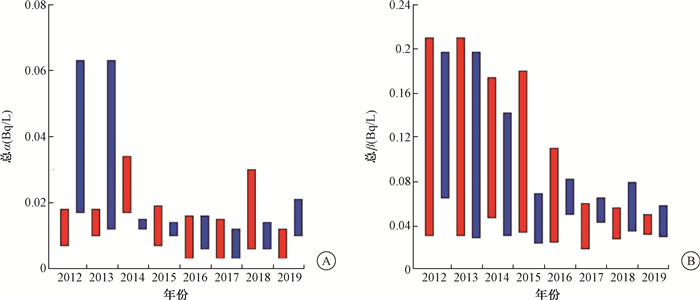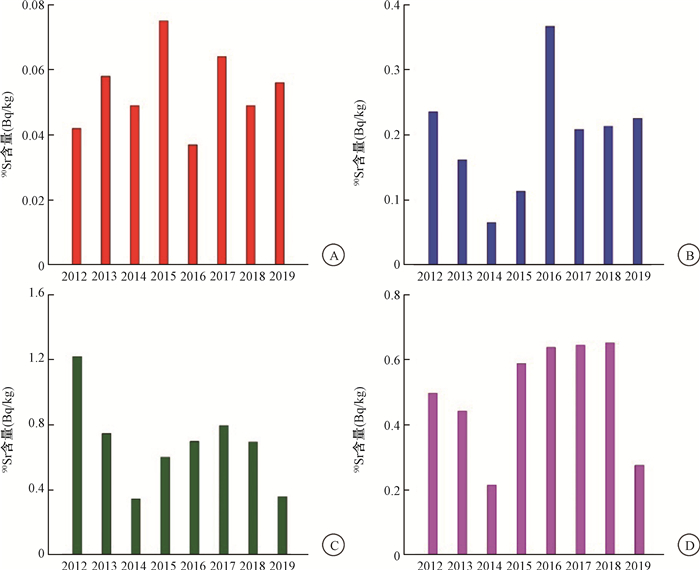2. 三门县疾病预防控制中心 317100
2. The Center for Disease Control and Prevention of Sanmen County, Sanmen 317100, China
核电作为清洁能源,已经成为我国能源结构的重要组成部分[1]。三门核电站坐落于浙江省东部沿海,一期工程首先建设两台100万千瓦级第三代压水堆技术机组(AP1000), 并已于2018年4月29日顺利完成装料,6月21日实现反应堆首次临界。
核电站本身含有放射性物质,存在着放射性物质外泄漏而造成严重影响环境和周围居民健康的可能性[2-3]。在三门核电站运行前后,持续开展其周围环境的放射性水平的研究分析,及时掌握放射性水平动态变化十分必要。本研究拟分析核电站运行前后周围生活饮用水中总α、总β放射性水平及食品中90Sr放射性水平,为三门核电站潜在放射性污染评估提供关键性基础数据,为公众防护对策研究提供参考依据[4-5]。
资料与方法1.样品采集:三门县西高东低,主要河流有7条,河流短小,水位季节变化明显,大部分直接汇入东海;地下水资源量为15 018万m3,其利用主要形式是饮用水、灌溉及工矿企业用水;三门县建有完整的给水系统,末梢水均来自市政自来水公司。根据三门县地形特点和水源、水厂分布,按照距核电站0~10 km、10~25 km的范围选择7个监测点:分别为水源水(5个)、出厂水(1个)和末梢水(1个)。丰水期采样为每年5月份,枯水期采样为每年10月份,每份生活饮用水样品采集10 L[6]。结合当地居民饮食习惯,采集当地生长的食品共4类,每年采集1次。2018年4月29日装料前采集的样品作为三门核电站运行前的样品,之后采集的样品作为三门核电站运行后的样品。核电站运行后,分别在其运行后的1、6、12、18个月采集水样,运行后的1、13个月采集包菜、鲫鱼,运行后的7、19个月采集大米、鲻鱼。具体监测点信息见表 1。
|
|
表 1 样品监测点信息 Table 1 Information on sample monitoring points |
2.仪器:低本底总α总β测量仪(BH1216Ⅲ型二路低本底α β测量仪,北京核仪器厂),石墨电热板(YKM-400C,长沙永乐康仪器设备有限公司),马弗炉(上海赛默飞世尔科技有限公司),万分之一电子天平[AE-2000,梅特勒-托利多仪器(上海)有限公司]、干燥箱[BINDER环境测试设备(上海)有限责任公司]、离心机(5810,德国Eppendorf公司)
3.试剂:无水乙醇(分析纯,安徽安特食品股份有限公司)、硫酸、丙酮、盐酸、过氧化氢、硝酸(分析纯, 上海凌峰化学试剂有限公司),草酸[分析纯, 常熟永华化学科技(江苏)有限公司]、氨水(分析纯, 杭州龙山精细化工有限公司)、二-(2-乙基己基)磷酸(60~80目,北京博瑞赛科技有限责任公司),水(符合GB/T 6682-2008规定的二级水)。
标准源:α源:241Am标准物质,质量活度为10.2 Bq/g,核素编号Am1203281;β源:KCl标准物质,质量活度为14.4 Bq/g,核素编号K1203282;均由中国计量科学研究院在2012年和2018年检定,并提供测试报告[7],证书编号分别为DYhd2012-0516、DYhd2018-1519。90Sr-90Y标准溶液:比活度为9.78 Bq/g的0.1 mol/L硝酸溶液(Sr-Y,证书编号RYSR90180726)。
4.检测方法
(1) 生活饮用水:按照《GB/T 5750.13—2006生活饮用水标准检验方法放射性指标》[8],检测水样中总α总β放射性活度浓度。
(2) 食品:采集的食品分别进行清洗、干燥、炭化、灰化等预处理操作[9]。2016年9月20日之前的食品样按照GB/T 11222.1-89《生物样品灰中锶-90的放射化学分析方法二-(2-乙基己基)磷酸酯萃取色层法》[10],2016年9月20日之后的样品按照GB14883.3-2016 《食品中放射性物质锶-89和锶-90的测定》[11]进行90Sr分析检测。
5.质量保证:低本底总α总β测量仪在检测样品之前,使用电镀源、标准源进行效率刻度和校正,且仪器处在检定周期内,检定合格。每年均参加由中国疾病预防控制中心辐射防护与核安全医学所组织的全国生活饮用水中总α、总β放射性能力比对考核,成绩多次优秀。每年均参加中国疾病预防控制中心辐射防护与核安全医学所组织的90Sr实验室间比对及现场质量控制,实验数据准确可靠。
结果1.生活饮用水中总放射性水平:三门核电站运行前,生活饮用水中总α、总β放射性活度浓度范围为0.001~0.063和0.019~0.210 Bq/L,其中,丰水期内总α、总β放射性活度浓度范围分别为0.001~0.034和0.019~0.210 Bq/L,枯水期内总α、总β放射性活度浓度范围分别为0.003~0.063和0.024~0.197 Bq/L。核电站运行后,生活饮用水中总α、总β放射性活度浓度范围为0.001~0.084和0.025~0.079 Bq/L,其中,丰水期内总α、总β放射性活度浓度范围分别为0.001~0.084和0.028~0.056 Bq/L,枯水期内总α、总β放射性活度浓度范围分别为0.004~0.021和0.025~0.079 Bq/L。
2.不同时期生活饮用水中总放射性水平:2012—2019年,三门核电站周围不同时期生活饮用水总α、总β放射性活度浓度范围见图 1。

|
注:红色代表丰水期;蓝色代表枯水期 图 1 2012—2019年三门核电站周围生活饮用水总放射性水平范围 A.总α放射性;B.总β放射性 Figure 1 Gross radioactivity level in drinking water around Sanmen nuclear power plant from 2012 to 2019 A. Gross α radioactive range; B. Gross β radioactive range |
3.不同类型及不同采样距离生活饮用水中总放射性水平:三门核电站运行前、后,三门核电站周围不同类型、距核电站不同距离生活饮用水中总α总β放射性处于较低水平,具体结果见表 2。
|
|
表 2 不同类型和距核电站不同距离生活饮用水中总放射性活度浓度(Bq/L) Table 2 Gross activity concentrations in different types of drinking water at different distances from nuclear power plant(Bq/L) |
4.不同类型食品中90Sr放射性水平:核电站运行前、后,大米中90Sr放射性活度浓度分别为0.037~0.075和0.049~0.056 Bq/kg,包菜分别为0.065~0.366和0.213~0.225 Bq/kg,鲫鱼分别为0.342~1.216和0.356~0.692 Bq/kg,鲻鱼分别为0.214~0.645和0.275~0.652 Bq/kg,均处于较低水平,具体结果见图 2。

|
图 2 2012—2019年三门核电站周围不同食品类型中90Sr放射性活度浓度 A.大米;B.包菜;C.鲫鱼;D.鲻鱼 Figure 2 Activity concentration of 90Sr in different types of food around Sanmen Nuclear Power Plant from 2012 to 2019 A. Rice; B. Cabbage; C. Crucian carp; D. Mullet |
讨论
本研究结果表明,三门核电站正式运行前后,核电站周围生活饮用水中总α、总β放射性活度浓度均远低于GB 5749-2006《生活饮用水卫生标准》规定的总α、总β放射性指导值(分别为0.5和1.0 Bq /L)[8],均处于正常本底水平。8年来,三门生活饮用水中总α、总β放射性活度浓度未见明显变化,这表明三门核电站的运行,对生活饮用水的放射性水平未见明显贡献,未引起放射性污染。2012—2014年,生活饮用水中总放射性水平略高,可能与福岛核事故的影响有关,有研究表明福岛核事故后,杭州雨水中检测到微量131I[12],上海地区气溶胶放射性水平明显升高,东海表层水体具有较高放射性的海水有向浙闽沿岸输运的趋势,可能会对中国近海环境造成一定的影响,但仍处于放射性本底范围内[13]。
运行前后,核电站周围不同采样距离、不同类型(水源水、出厂水、末梢水)及不同时期(丰水期、枯水期)的生活饮用水中总放射性水平均未见明显变化。研究结果显示,水源水总放射性水平均高于出厂水和末梢水,可能与水源水总放射性来源主要为地壳岩石矿物或土壤中深层地下水、泉水等,含有相对较高的天然放射性核素有关[14]。总体而言,枯水期总放射性略高于丰水期,这可能与总放射性也来自于放射性气溶胶、大气降水和颗粒物的干沉降,枯水期放射性沉降相对较多以及丰水期雨水的稀释作用[15]有关。
90Sr属于高毒性、亲骨核素,可长久停留在造血的骨骼系统,引起辐射疾病,是核环境监测和人体健康风险评估中备受关注的信号核素[16]。2012—2019年,食品中90Sr放射性活度浓度动态变化整体一致,运行前后均未见明显变化,说明三门核电站的运行,未引起食品中90Sr放射性水平变化。三门核电站运行前后,4类食品90Sr放射性活度浓度均低于GB 14882-1994《食品中放射性物质限制浓度标准》指导值[17],处于本底水平。90Sr放射性水平:淡水鱼>海鱼>青菜>谷类,这可能是由于浙江省地处东南沿海,长江中下游河口地带,通常河口地区在海水的稀释作用下,近海岸淡水放射性水平高于海洋,进而造成淡水鱼放射性水平高于海鱼。此外,本研究发现,肉类食品的放射性高于初级生产者菜类食品,这符合食物链富集效应,与吕鲜臻等[18]的研究一致。
本研究与前人对全国核电站的研究,包括大亚湾核电站[19]、秦山核电站[5, 20]、三门核电站[21]、海阳核电站[22]、田湾核电站[23]、红沿河核电站[15]、防城港核电站[24]的结果一致。本研究在三门核电站运行前后的8年时间内,持续开展生活饮用水和食品中放射性水平研究,积累了三门核电站环境放射性本底数据,及时有效地分析了放射性动态水平。因三门核电站运行时间较短,本研究将持续采集样品分析以监测其变化情况。
志谢 本研究还得到浙江省疾病预防控制中心疾控英才孵育项目资助;感谢三门县卫生健康局祁先群、三门县疾病预防控制中心林咸镯、杨盛旭、郑涛涛等对本研究的支持和奉献
利益冲突 本文由署名作者按以下贡献声明独立开展,不涉及各相关方的利益冲突
作者贡献声明 曹艺耀负责实验组织、数据整理分析、论文撰写和修改;俞顺飞负责食品灰化处理、食品检测;宣志强、王子友负责组织协调;任鸿、王鹏、郦依华、赵尧贤、罗进、赖忠俊负责食品采集及预处理
| [1] |
国家核安全局. 2016全国辐射环境质量报告[EB/OL].(2017-08-22)[2020-01-18]. http://nnsa.mee.gov.cn/ywdh/jcyj/,2016. National Nuclear Safety Administration. 2016 report of the national radiation environmental quality[EB/OL].(2017-08-22)[2020-01-18]. http://nnsa.mee.gov.cn/ywdh/jcyj/,2016. |
| [2] |
Pidgeon NF, Lorenzoni I, Poortinga W. Climate change or nuclear power-No thanks! A quantitative study of public perceptions and risk framing in Britain[J]. Global Environ Change, 2008, 18(1): 69-85. DOI:10.1016/j.gloenvcha.2007.09.005 |
| [3] |
Cardis E, Hatch M. The Chernobyl accident-an epidemiological perspective[J]. Clin Oncol, 2011, 23(4): 251-260. DOI:10.1016/j.clon.2011.01.510 |
| [4] |
叶常青. 我国核与辐射事故应急关键技术及公众防护对策研究进展[J]. 中华放射医学与防护杂志, 2011, 31(2): 119-121. Ye CQ. Research progress on key technologies of nuclear and radiological accident emergency and countermeasures of public protection in China[J]. Chin J Radiol Med Prot, 2011, 31(2): 119-121. DOI:10.3760/cma.j.issn.0254-5098.2011.02.001 |
| [5] |
宣志强, 曹艺耀, 俞顺飞, 等. 秦山核电站周围生活饮用水总放射性水平调查[J]. 预防医学, 2016, 28(11): 1091-1094. Xuan ZQ, Cao YY, Yu SF, et al. Investigation on the total radioactivity level of drinking water around Qinshan Nuclear Power Plant[J]. Prev Med, 2016, 28(11): 1091-1094. |
| [6] |
卫生部. 核电站30公里内纳入生活饮用水卫生监测[J]. 广西质量监督导报, 2012, 18(1): 6. Ministry of Health of the People's Republic of China. Drinking water sanitation monitoring shall be carried out within 30 kilometers of nuclear power plant[J]. Guangxi Qual Suprev Rep, 2012, 18(1): 6. |
| [7] |
沈乐园, 王利华, 徐萍. 水中总α、总β放射性测定中标准物质的选取[J]. 污染防治技术, 2013, 26(4): 74-76. Shen LY, Wang LH, Xu P. Selection of standard substances in the determination of total radioactivity in water[J]. Pollut Control Technol, 2013, 26(4): 74-76. |
| [8] |
卫生部. GB 5749-2006生活饮用水卫生标准[S].北京: 中国标准出版社, 2006. Ministry of Health of the People's Republic of China. GB 5749-2006 Hygienic standard for drinking water[S]. Beijing: Standards Press of China, 2006. |
| [9] |
曹艺耀, 俞顺飞, 宣志强, 等. 食品放射性监测的快速微波灰化预处理方法研究[J]. 中华放射医学与防护杂志, 2018, 38(1): 43-47. Cao YY, Yu SF, Xuan ZQ, et al. Study on rapid microwave ashing pretreatment method for radioactivity monitoring in food[J]. Chin J Radiol Med Prot, 2018, 38(1): 43-47. DOI:10.3760/cma.jissn.0254-5098.2018.01.009 |
| [10] |
国家环境保护局. GB/T 11222.1-89生物样品灰中锶-90的放射化学分析方法二-(2-乙基已基)磷酸酯萃取色层法[S].北京: 中国标准出版社, 1990. National Environmental Protection Administration. GB/T 11222.1-89 Radiochemical analysis of strontium-90 in ash of biological samples-Extraction chromatography by di-(2-ethylhexyl) phosphate[S]. Beijing: Standards Press of China, 1990. |
| [11] |
国家卫生和计划生育委员会. GB 14883.3-2016食品中放射性物质检验锶-89和锶-90的测定[S].北京: 中国标准出版社, 2016. National Health and Family Planning Commission. GB 14883.3-2016 Determination of strontium-89 and strontium-90 for radioactive substances in food[S].Beijing: Standards Press of China, 2016. |
| [12] |
刘鸿诗, 胡丹, 向元益, 等. 日本福岛核事故期间浙江省环境放射性的监测结果及分析[J]. 辐射防护, 2012, 32(6): 380-385, 391. Liu HS, Hu D, Xiang YY, et al. Monitoring results and analysis of environmental radioactivity in Zhejiang province during Japan's Fukushima Nuclear Power Station accident[J]. Radiat Prot, 2012, 32(6): 380-385, 391. |
| [13] |
刘丹彤.福岛核事故后典型放射性核素在中国近海环境中分布和迁移特征分析[D].上海: 华东师范大学, 2016. Liu DT. Analysis of the distribution and migration characteristics of typical radionuclides in the offshore environment of China after the Fukushima nuclear accident[D]. Shanghai: East China Normal University, 2016. http://cdmd.cnki.com.cn/Article/CDMD-10269-1016138324.htm |
| [14] |
刘英. 国家《生活饮用水卫生标准》中总α和总β放射性标准适用性的探讨[J]. 中国公共卫生, 1997, 13(1): 34-36. Liu Y. Discussion on the applicability of the national hygienic standards for drinking water[J]. Chin J Public Health, 1997, 13(1): 34-36. |
| [15] |
赵叙, 徐峰, 赵丹, 等. 红沿河核电站周边水域放射性水平调查[J]. 中国辐射卫生, 2016, 25(5): 586-587. Zhao X, Xu F, Zhao D, et al. Investigation of radioactivity level in waters around Hongyanhe Nuclear Power Plant[J]. Chin J Radiol Health, 2016, 25(5): 586-587. DOI:10.13491/j.cnki.issn.1004-714x.2016.05.034 |
| [16] |
United Nations Scientific Committee on the Effects of Atomic Radiation. UNSCEAR 2000 report. Sources and effects of ionizing radiation[R]. New York: UNSCEAR, 2000.
|
| [17] |
卫生部. GB 14882-1994食品中放射性物质限制浓度标准[S].北京: 中国标准出版社, 1994. Ministry of Health of the People's Republic of China. GB 14882-94 Standard for limiting concentrations of radioactive substances in food[S]. Beijing: Standards Press of China, 1994. |
| [18] |
吕鲜臻, 王志超, 陈星迪, 等. 钱塘江流域(杭州段)水环境中多氯联苯的生物富集效应[J]. 杭州师范大学学报(自然科学版), 2015, 14(5): 483-488. Lyu XZ, Wang ZC, Chen XD, et al. Biological enrichment effect of PCBS in water environment of Qiantang river basin (Hangzhou section)[J]. J Hangzhou Norm Univ, 2015, 14(5): 483-488. DOI:10.3969/j.issn.1674-232X.2015.05.006 |
| [19] |
吉长余, 张东果. 大亚湾核电站1994-2003年环境辐射监测结果与分析[J]. 辐射防护, 2004, 24(3): 173-190. Ji CY, Zhang DG. Environmental radiation monitoring results and analysis of Daya bay nuclear power plant from 1994 to 2003[J]. Radiat Prot, 2004, 24(3): 173-190. DOI:10.3321/j.issn.1000-8187.2004.03.006 |
| [20] |
李海.秦山核电站周围地区辐射环境监测与分析[D].衡阳: 南华大学, 2012. Li H. Monitoring and analysis of radiation environment around Qinshan Nuclear Power Plant[D]. Hengyang: South China University, 2012. http://cdmd.cnki.com.cn/Article/CDMD-10555-1013341709.htm |
| [21] |
王子友, 宣志强, 郑士长, 等. 三门核电站周围环境放射性水平的基线调查[J]. 浙江预防医学, 2013, 25(5): 58-60. Wang ZY, Xuan ZQ, Zheng SC, et al. Baseline survey of environment radioactivity level around Sanmen Nuclear Power Plant[J]. Zhejiang J Prev Med, 2013, 25(5): 58-60. DOI:10.19485/j.cnki.issn.1007-0931.2013.05.022 |
| [22] |
刘亚奇, 张巍, 李群伟, 等. 海阳核电站运行前周边地区食品中放射性水平及所致居民剂量[J]. 中国辐射卫生, 2016, 25(2): 146-149. Liu YQ, Zhang W, Li QW, et al. Radioactivity level in food and the dose to residents in the surrounding area before the operation of Haiyang Nuclear Power Plant[J]. Chin J Radiol Health, 2016, 25(2): 146-149. DOI:10.13491/j.cnki.issn.1004-714x.2016.02.006 |
| [23] |
陈群.江苏省田湾核电站周围辐射水平调查[D].南京: 东南大学, 2011. Chen Q. Radiation level survey around Tianwan Nuclear Power Plant in Jiangsu province[D]. Nanjing: Southeast University, 2011. http://d.wanfangdata.com.cn/thesis/Y1977233 |
| [24] |
黄飞, 谢海, 谢萍, 等. 2012年防城港市某核电站周边居民生活饮用水总放射性水平监测[J]. 应用预防医学, 2013, 19(4): 241-242. Huang F, Zie H, Xie P, et al. Monitoring of total radioactivity level in drinking water of residents around a nuclear power plant in Fangchenggang city in 2012[J]. Applied Prev Med, 2013, 19(4): 241-242. DOI:10.3969/j.issn.1673-758x.2003.04.021 |
 2020, Vol. 40
2020, Vol. 40


